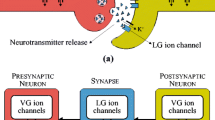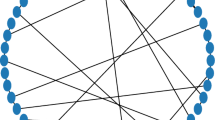Abstract
We studied the detailed structure of a neuronal network model in which the spontaneous spike activity is correctly optimized to match the experimental data and discuss the reliability of the optimized spike transmission. Two stochastic properties of the spontaneous activity were calculated: the spike-count rate and synchrony size. The synchrony size, expected to be an important factor for optimization of spike transmission in the network, represents a percentage of observed coactive neurons within a time bin, whose probability approximately follows a power-law. We systematically investigated how these stochastic properties could matched to those calculated from the experimental data in terms of the log-normally distributed synaptic weights between excitatory and inhibitory neurons and synaptic background activity induced by the input current noise in the network model. To ensure reliably optimized spike transmission, the synchrony size as well as spike-count rate were simultaneously optimized. This required changeably balanced log-normal distributions of synaptic weights between excitatory and inhibitory neurons and appropriately amplified synaptic background activity. Our results suggested that the inhibitory neurons with a hub-like structure driven by intensive feedback from excitatory neurons were a key factor in the simultaneous optimization of the spike-count rate and synchrony size, regardless of different spiking types between excitatory and inhibitory neurons.










Similar content being viewed by others
References
Baker JL, Olds JL (2007) Theta phase precession emerges from a hybrid computational model of a CA3 place cell. Cogn Neurodyn 1(3):237–248
Beggs JM, Plenz D (2003) Neuronal avalanches in neocortical circuits. J Neurosci 23(35):11167–11177
Bonifazi P, Goldin M, Picardo MA, Jorquera I, Cattani A, Bianconi G, Represa A, Ben-Ari Y, Cossart R (2009) GABAergic hub neurons orchestrate synchrony in developing hippocampal networks. Science 326(5958):1419–1424
Brown EN, Kass RE, Mitra PP (2004) Multiple neural spike train data analysis: state-of-the-art and future challenges. Nat Neurosci 7(5):456–461
Brown E, Moehlis J, Holmes P (2004) On the phase reduction and response dynamics of neural oscillator populations. Neural Comput 16:673–715
Cohen I, Miles R (2000) Contributions of intrinsic and synaptic activities to the generation of neuronal discharges in in vitro hippocampus. J Physiol 524(Pt 2):485–502
Fujisawa S, Matsuki N, Ikegaya Y (2006) Single neurons can induce phase transitions of cortical recurrent networks with multiple internal states. Cereb Cortex 16(5):639–654
Gulyás AI, Miles R, Hájos N, Freund TF (1993) Precision and variability in postsynaptic target selection of inhibitory cells in the hippocampal CA3 region. Eur J Neurosci 5(12):1729–1751
Hampson RE, Pons TP, Stanford TR, Deadwyler SA (2004) Categorization in the monkey hippocampus: a possible mechanism for encoding information into memory. Proc Natl Acad Sci USA 101(9):3184–3189
Hampson RE, Song D, Opris I, Santos LM, Shin DC, Gerhardt GA, Marmarelis VZ, Berger TW, Deadwyler SA (2013) Facilitation of memory encoding in primate hippocampus by a neuroprosthesis that promotes task-specific neural firing. J Neural Eng 10(6):066013
Heinzle J, König P, Salazar RF (2007) Modulation of synchrony without changes in firing rates. Cog Neurodyn 1:225–235
Helmchen F, Svoboda K, Denk W, Tank DW (1999) In vivo dendritic calcium dynamics in deep-layer cortical pyramidal neurons. Nat Neurosci 2(11):989–996
Hiratani N, Teramae JN, Fukai T (2013) Associative memory model with long-tail-distributed Hebbian synaptic connections. Front Comput Neurosci 6:102
Ikegaya Y, Sasaki T, Ishikawa D, Honma N, Tao K, Takahashi N, Minamisawa G, Ujita S, Matsuki N (2013) Interpyramid spike transmission stabilizes the sparseness of recurrent network activity. Cereb Cortex 23(2):293–304
Izhikevich EM (2003) Simple model of spiking neurons. IEEE Trans Neural Netw 14:1569–1572
Izhikevich EM (2007) Dynamical systems in neuroscience: the geometry of excitability and bursting. MIT Press, Cambridge, MA
Jensen MS, Azouz R, Yaari Y (1996) Spike after-depolarization and burst generation in adult rat hippocampal CA1 pyramidal cells. J Physiol 492:199–210
Jiruska P, Csicsvari J, Powell AD, Fox JE, Chang WC, Vreugdenhil M, Li X, Palus M, Bujan AF, Dearden RW, Jefferys JG (2010) High-frequency network activity, global increase in neuronal activity, and synchrony expansion precede epileptic seizures in vitro. J Neurosci 30(16):5690–5701
Kesner RP (2007) Behavioral functions of the CA3 subregion of the hippocampus. Learn Mem 14(11):771–781
Kinouchi O, Copelli M (2006) Optimal dynamical range of excitable networks at criticality. Nat Phys 2:348–351
Klaus A, Yu S, Plenz D (2011) Statistical analyses support power law distributions found in neuronal avalanches. PLoS one 6(5):e19779
Kwok HF, Jurica P, Raffone A, van Leeuwen C (2007) Robust emergence of small-world structure in networks of spiking neurons. Cogn Neurodyn 1(1):39–51
Larremore DB, Shew WL, Restrepo JG (2011) Predicting criticality and dynamic range in complex networks: effects of topology. Phys Rev Lett 106(5):058101
Lefort S, Tomm C, Floyd Sarria JC, Petersen CC (2009) The excitatory neuronal network of the C2 barrel column in mouse primary somatosensory cortex. Neuron 61(2):301–316
Li XG, Somogyi P, Ylinen A, Buzsáki G (1994) The hippocampal CA3 network: an in vivo intracellular labeling study. J Comp Neurol 339(2):181–208
Li S, Wu S (2007) Robustness of neural codes and its implication on natural image processing. Cogn Neurodyn 1(3):261–272
Miles R, Wong RKS (1983) Single neurones can initiate synchronized population discharge in the hippocampus. Nature 306:371–373
Sarid L, Bruno R, Sakmann B, Segev I, Feldmeyer D (2007) Modeling a layer 4-to-layer 2/3 module of a single column in rat neocortex: interweaving in vitro and in vivo experimental observations. Proc Natl Acad Sci USA 104(41):16353–16358
Sasaki T, Matsuki N, Ikegaya Y (2007) Metastability of active CA3 networks. J Neurosci 27(3):517–528
Shew WL, Yang H, Petermann T, Roy R, Plenz D (2009) Neuronal avalanches imply maximum dynamic range in cortical networks at criticality. J Neurosci 29(49):15595–15600
Shew WL, Yang H, Yu S, Roy R, Plenz D (2011) Information capacity and transmission are maximized in balanced cortical networks with neuronal avalanches. J Neurosci 31(1):55–63
Shlizerman E, Holmes P (2012) Neural dynamics, bifurcations, and firing rates in a quadratic integrate-and-fire model with a recovery variable. I: deterministic behavior. Neural Comput 24(8):2078–2118
Singer W (2009) Distributed processing and temporal codes in neuronal networks. Cogn Neurodyn 3(3):189–196
Smith KL, Szarowski DH, Turner JN, Swann JW (1995) Diverse neuronal populations mediate local circuit excitation in area CA3 of developing hippocampus. J Neurophysiol 74(2):650–672
Song S, Sjöström PJ, Reigl M, Nelson S, Chklovskii DB (2005) Highly nonrandom features of synaptic connectivity in local cortical circuits. PLoS Biol 3(3):e68
Steyn-Ross DA, Steyn-Ross M (2010) Modeling phase transitions in the brain. Springer, New York
Takahashi N, Sasaki T, Matsumoto W, Matsuki N, Ikegaya Y (2010) Circuit topology for synchronizing neurons in spontaneously active networks. Proc Natl Acad Sci USA 107:10244–10249
Tateno K, Hayashi H, Ishizuka S (1998) Complexity of spatiotemporal activity of a neural network model which depends on the degree of synchronization. Neural Netw 11(6):985–1003
Taxidis J, Coombes S, Mason R, Owen MR (2012) Modeling sharp wave-ripple complexes through a CA3-CA1 network model with chemical synapses. Hippocampus 22(5):995–1017
Taxidis J, Mizuseki K, Mason R, Owen MR (2013) Influence of slow oscillation on hippocampal activity and ripples through cortico-hippocampal synaptic interactions, analyzed by a cortical-CA3-CA1 network model. Front Comput Neurosci 7:3
Teramae JN, Tsubo Y, Fukai T (2013) Optimal spike-based communication in excitable networks with strong-sparse and weak-dense links. Sci Rep 2:485
Touboul J, Brette R (2009) Spiking dynamics of bidimensional integrate-and-fire neurons. SIAM J Appl Dyn Syst 8(4):1462–1506
Traub RD, Miles R (1991) Neuronal networks of the hippocampus. Cambridge Univ Press, Cambridge
Wagatsuma H, Yamaguchi Y (2007) Neural dynamics of the cognitive map in the hippocampus. Cogn Neurodyn 1(2):119–141
Wang XJ, Buzsáki G (1996) Gamma oscillation by synaptic inhibition in a hippocampal interneuronal network model. J Neurosci 16(20):6402–6413
Yang H, Shew WL, Roy R, Plenz D (2012) Maximal variability of phase synchrony in cortical networks with neuronal avalanches. J Neurosci 32(3):1061–1072
Yoshida M, Hayashi H, Tateno K, Ishizuka S (2002) Stochastic resonance in the hippocampal CA3-CA1 model: a possible memory recall mechanism. Neural Netw 15(10):1171–1183
Acknowledgments
Y. D. S. was partially supported by a Grant-in-Aid for Challenging Exploring Research No. 25540110. Y. I. was partially supported by the Funding Program for Next Generation World-Leading Researchers (No. LS023).
Author information
Authors and Affiliations
Corresponding author
Rights and permissions
About this article
Cite this article
Samura, T., Ikegaya, Y. & Sato, Y.D. A neural network model of reliably optimized spike transmission. Cogn Neurodyn 9, 265–277 (2015). https://doi.org/10.1007/s11571-015-9329-1
Received:
Revised:
Accepted:
Published:
Issue Date:
DOI: https://doi.org/10.1007/s11571-015-9329-1




